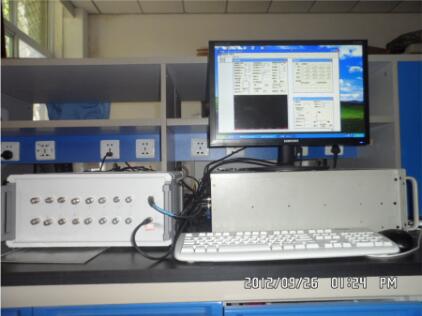| Array ultrasonic guided wave testing technology for pipelines |
| Function Summary |
| The hardware of array ultrasonic guided wave detection system for pipelines consists of an ultrasonic exciting and receiving card, a multi-channel digital output card, multi-channel control switches and the guided wave transducer array. The multi-channel control system, under the computer control software, can implement multiple sets of time-sharing signal rapid acquisition and data processing and display of the collected data, and then realizes the defect imaging of the tested workpiece. The system can detect the material surface and internal defects such as cracks, holes, and corrosion. It has large detection range and fast detection speed. |
 |
 |
| Array ultrasonic guided wave detection system for pipelines |
| Specifications |
| Number of channels: 16 |
| Detection distance: 2000mm |
| Channel switching speed: 8ms |
| Highest sample frequency: 100MHz |
| Excitation frequency range: 0.5 - 25MHz |
| Technical principle |
| Ultrasonic guided wave testing for pipeline defects, on the basis of large diameter pipeline guided wave dispersion curves, adopts specific guided wave excitation frequency and incentive mode. When there are pipeline defects in the internal and the external surfaces, the ultrasonic guided wave propagating along the pipelines encounters defects, and reflection, refraction and scattering phenomena will occur. Placing probes along the circumferential direction of the pipelines and making the probes into double loop arrays and the excited sound beam pointing in the direction of array center, if there is a defect inside the area covered by the array , the excited guided waves of the exciting probes and the reflecting waves due to the defects will be received by other probes. Then the defect must be on the ellipse whose two focuses are respectively the exciting probe and the receiving probe and whose major semi-axis is the multiplication of the tested time and the sound speed. After processing the exciting and receiving signals of the probe arrays, an image can be constructed by adding the generated ellipses, thus in this way, the shape, location and size of the defect can be obtained. |
| Technical features |
| Realizing the time sharing self-exciting and self-receiving, one exciting and multi-receiving and multi-exciting and multi-receiving |
| Using elliptical positioning and probability tomography algorithm, realizing the rapid detection of pipeline defects |
| Multiple sets of data storage and preservation |
| Defects detection for variety diameters and materials of pipelines |
| Applications |
| It can be applied to the detection of pipe components of metals and composite materials. |
| |
| |
| |
| |
| |

